Elephants
Nigeria
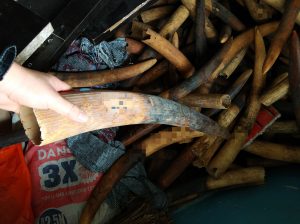
Ivory seizure in Nigeria
Nigeria’s non-compliance has been a recurring topic at CITES meetings for the past 20 years. The country has been subjected to a trade suspension in Pterocarpus erinaceus (under a mechanism referred to as ‘Article XIII’) since 2018 and just before the meeting in Lyon, it was recommended that this trade sanction be broadened to cover all CITES-listed species owing to unacceptably slow progress by Nigeria to tackle ivory and pangolin trafficking. In particular, concerns were raised about Nigeria’s failures to tackle organised criminal gangs behind trafficking; to address corruption amongst key government agencies; to untangle competing mandates of key government agencies tasked with tackling wildlife crime; and to abide by its reporting obligations.
Nigeria’s non-compliance with the National Ivory Action Plan (NIAP) process was also hotly debated in Lyon as grounds for a complete trade suspension under another mechanism (Res.Conf.14.3). The country has failed to provide a single progress report in a timely fashion since 2014 which has hampered the Secretariat’s efforts to analyse trends and resilience to ivory trafficking in the region. Content-wise, Nigeria’s NIAP and belated progress reports have not been satisfactory and include gaping loopholes that, for example, allow ivory to be traded legally in Lagos.
Given that Nigeria is the primary export hub for illegal pangolin and ivory, we lobbied hard for the Committee to impose full trade sanctions on Nigeria at the meeting in Lyon under both Article XIII and Res. Conf. 14.3. However, the Committee instead decided to give Nigeria a stay of execution, giving it until May 10th 2022 to submit a NIAP progress report and requested Nigeria to report on progress to address the array of recommendations made by the Committee by 14th September 2022. In the absence of progress, it is likely that trade suspension will be adopted under Article XIII and Res. Conf 14.3. While EIA welcomes the interventions made by Nigeria at the meeting whereby it reiterated its commitment to CITES and to its desire to align itself with its obligations under the Convention, it remains to be seen whether Nigeria will use its last chance to put words into action. Watch this space.
National Ivory Action Plan process
Unfortunately, EIA’s view that Vietnam has not overall made ‘’partial progress’’ in its NIAP implementation was not heeded by the Committee. As reported in a recent briefing, we believe serious gaps in the Party’s progress report remain, including a marked absence of prosecutions for ivory or pangolin scale seizures at seaports and a lack of international cooperation to conduct intelligence-led investigations into organised criminal syndicates trafficking wildlife. As we look to CoP19, we will continue to prioritise Vietnam as a key country involved in illegal ivory and rhino horn trade and will call for appropriate measures to be taken should Vietnam fail to address its role as a leading destination for endangered wildlife.
EIA also made an intervention on behalf of 11 NGOs to draw attention to the fact that, nearly a decade since its inception, it is high time that the NIAP process undergoes a robust review to ensure it is still fit for purpose. This is especially critical given that several countries are required to report against completely outdated action plans which may no longer be accurate or proportional to their evolving roles in ivory trafficking. Ahead of CoP19, we will seek support for a review to ensure the NIAP process does not duplicate existing mechanisms under CITES that already address enforcement and compliance matters relating to ivory trafficking and we will also call for greater use of existing tools and sources of data such as the ICCWC Framework and Toolkit. We believe without a review, the NIAP process risks straying from its original purpose, becoming burdensome for Parties and the Secretariat.
Ivory stocks and stockpiles
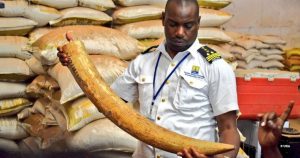 Ivory stockpiles held by Governments are a serious threat to elephants through leakage of ivory onto the illegal trade as thefts from stockpiles are frequent, fuelling demand and perpetuating ivory’s status as a marketable commodity. The thefts and illegal sales of ivory from stockpiles usually involves corruption and international criminal networks and EIA welcomed the strong interventions made by Gabon, Kenya and Ethiopia reminding the Committee that stockpiles need to be accounted for in a transparent, secure and consistent manner. Along with a number of our partner NGOs, we expressed concern that 44 countries, including NIAP countries, who hold ivory stocks have never reported on their inventories and called on them to do so as a matter of urgency. Given the level of non-reporting and the importance of stockpile data, we were therefore pleased that the Committee reiterated requests to Parties to step up their efforts to comply with stockpile reporting obligations. Looking forward to CoP19, we will work to ensure that this critical topic remains on the table to ensure a holistic response to elephant poaching and ivory trafficking.
Ivory stockpiles held by Governments are a serious threat to elephants through leakage of ivory onto the illegal trade as thefts from stockpiles are frequent, fuelling demand and perpetuating ivory’s status as a marketable commodity. The thefts and illegal sales of ivory from stockpiles usually involves corruption and international criminal networks and EIA welcomed the strong interventions made by Gabon, Kenya and Ethiopia reminding the Committee that stockpiles need to be accounted for in a transparent, secure and consistent manner. Along with a number of our partner NGOs, we expressed concern that 44 countries, including NIAP countries, who hold ivory stocks have never reported on their inventories and called on them to do so as a matter of urgency. Given the level of non-reporting and the importance of stockpile data, we were therefore pleased that the Committee reiterated requests to Parties to step up their efforts to comply with stockpile reporting obligations. Looking forward to CoP19, we will work to ensure that this critical topic remains on the table to ensure a holistic response to elephant poaching and ivory trafficking.
Closure of domestic ivory markets
Discussions at SC74 demonstrated that support for the closure of domestic ivory markets remains strong among most CITES Parties. While the CITES Secretariat had prematurely recommended the deletion of the decision directing Parties that had not closed their ivory markets to report on measures they are taking to ensure that those markets are not contributing to poaching or illegal trade, SC74 firmly rejected this recommendation and endorsed the calls from Burkina Faso, Gabon, the US, the UK, the EU, Israel, and China to instead renew the decision at CoP19.
A number of Parties, including the US and Gabon, emphasised the role that legal domestic ivory markets play in contributing to illegal trade. Burkina Faso referenced an information document submitted by Senegal and Liberia to describe how Japan’s legal domestic ivory market, which with an estimated 244 tonnes of legal stockpiled ivory is the largest legal domestic market in the world, is contributing to the illegal international trade. A joint briefing for SC74 prepared by EIA and the Japan Tiger and Elephant Fund reviews the myriad of problems with Japan’s domestic ivory controls.
Despite the widely available evidence that Japanese ivory is being trafficked abroad, Japan maintains the view that its ivory market does not contribute to illegal trade and is therefore in line with CITES provisions on domestic market closure. However, EIA has documented more than 70 seizures of ivory from Japan made by China’s authorities between 2018-20, which indicates that Japan’s legal market is contributing to the international illegal trade. In what will hopefully remove any shred of doubt, SC74 agreed to a proposal by the EU to have the Elephant Trade Information System (a CITES initiative to monitor illegal ivory trade) report that is submitted to CoP19 include an analysis of ivory seizures connected to Parties with legal domestic ivory markets, if feasible.




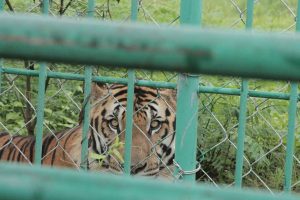
 Since CoP17, the Government of India has been promoting the use of tiger stripe pattern profiling analysis to support investigations into the origin of tigers in trade. The process has helped India and Nepal collaborate on cross-border trade. All Parties that make seizures are supposed to send images of skins to India and Thailand as the two Parties with stripe pattern databases. Despite there having been over 500 seizures of skins, carcasses, live animals and taxidermy specimens globally since CoP17, only a handful of images from Vietnam have been shared with India. It’s such a low cost way of sharing non-sensitive information that could facilitate enforcement, it is shocking that such little action has been taken by Parties making seizures. At this meeting, the call for a better response was made. Let’s see in a few months who was listening.
Since CoP17, the Government of India has been promoting the use of tiger stripe pattern profiling analysis to support investigations into the origin of tigers in trade. The process has helped India and Nepal collaborate on cross-border trade. All Parties that make seizures are supposed to send images of skins to India and Thailand as the two Parties with stripe pattern databases. Despite there having been over 500 seizures of skins, carcasses, live animals and taxidermy specimens globally since CoP17, only a handful of images from Vietnam have been shared with India. It’s such a low cost way of sharing non-sensitive information that could facilitate enforcement, it is shocking that such little action has been taken by Parties making seizures. At this meeting, the call for a better response was made. Let’s see in a few months who was listening. Despite everyone agreeing that Laos has not made adequate progress towards effective enforcement or in
Despite everyone agreeing that Laos has not made adequate progress towards effective enforcement or in 
 Ivory stockpiles held by Governments are a serious threat to elephants through leakage of ivory onto the illegal trade as thefts from stockpiles are frequent, fuelling demand and perpetuating ivory’s status as a marketable commodity. The thefts and illegal sales of ivory from stockpiles usually involves corruption and international criminal networks and EIA welcomed the strong interventions made by Gabon, Kenya and Ethiopia reminding the Committee that stockpiles need to be accounted for in a transparent, secure and consistent manner. Along with a number of our partner NGOs, we expressed concern that 44 countries, including NIAP countries, who hold ivory stocks have never reported on their inventories and called on them to do so as a matter of urgency. Given the level of non-reporting and the importance of stockpile data, we were therefore pleased that the Committee reiterated requests to Parties to step up their efforts to comply with stockpile reporting obligations. Looking forward to CoP19, we will work to ensure that this critical topic remains on the table to ensure a holistic response to elephant poaching and ivory trafficking.
Ivory stockpiles held by Governments are a serious threat to elephants through leakage of ivory onto the illegal trade as thefts from stockpiles are frequent, fuelling demand and perpetuating ivory’s status as a marketable commodity. The thefts and illegal sales of ivory from stockpiles usually involves corruption and international criminal networks and EIA welcomed the strong interventions made by Gabon, Kenya and Ethiopia reminding the Committee that stockpiles need to be accounted for in a transparent, secure and consistent manner. Along with a number of our partner NGOs, we expressed concern that 44 countries, including NIAP countries, who hold ivory stocks have never reported on their inventories and called on them to do so as a matter of urgency. Given the level of non-reporting and the importance of stockpile data, we were therefore pleased that the Committee reiterated requests to Parties to step up their efforts to comply with stockpile reporting obligations. Looking forward to CoP19, we will work to ensure that this critical topic remains on the table to ensure a holistic response to elephant poaching and ivory trafficking.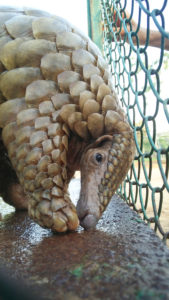 Under Agenda Item 73 on pangolins, the SC accepted comments from Parties to encourage species-level identification and reporting of seized pangolin specimens, as well as the urgent establishment of stricter controls in securing stockpiles of pangolin derivatives. The acceptance of these comments could prove instrumental in identifying vulnerable pangolin populations and informing targeted enforcement and demand reduction efforts. Additionally, the implementation of more stringent stockpile management measures could reduce the laundering of illegally sourced pangolin derivatives.
Under Agenda Item 73 on pangolins, the SC accepted comments from Parties to encourage species-level identification and reporting of seized pangolin specimens, as well as the urgent establishment of stricter controls in securing stockpiles of pangolin derivatives. The acceptance of these comments could prove instrumental in identifying vulnerable pangolin populations and informing targeted enforcement and demand reduction efforts. Additionally, the implementation of more stringent stockpile management measures could reduce the laundering of illegally sourced pangolin derivatives.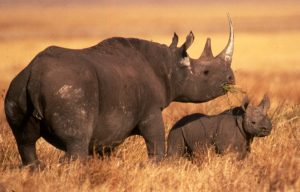 During the discussion on the rhinoceros agenda item, Kenya intervened to remind Parties that despite the important actions underway to protect rhinos from poaching and prosecute rhino horn traffickers, poaching and illegal trade remain very serious issues in source and consumer countries. Kenya further recognised that it would be especially beneficial to bring law enforcement experts together again to create new strategies and actions to protect rhinos, and called on the SC to recommend that CoP19 reconvene the CITES Rhinoceros Enforcement Task Force. The US also expressed support for reconvening the Task Force, noting it has been nearly 10 years since it last met. The SC subsequently agreed to propose a decision to CoP19 to reconvene the CITES Rhino Enforcement Task Force subject to available funding.
During the discussion on the rhinoceros agenda item, Kenya intervened to remind Parties that despite the important actions underway to protect rhinos from poaching and prosecute rhino horn traffickers, poaching and illegal trade remain very serious issues in source and consumer countries. Kenya further recognised that it would be especially beneficial to bring law enforcement experts together again to create new strategies and actions to protect rhinos, and called on the SC to recommend that CoP19 reconvene the CITES Rhinoceros Enforcement Task Force. The US also expressed support for reconvening the Task Force, noting it has been nearly 10 years since it last met. The SC subsequently agreed to propose a decision to CoP19 to reconvene the CITES Rhino Enforcement Task Force subject to available funding.
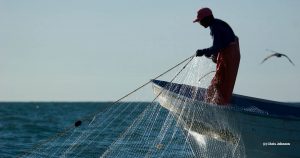 On the second day, the Standing Committee considered a report from the Secretariat which assessed the actions taken by Mexico to comply with CoP Decision 18.293, which requested that Mexico implement seven actions to address the illegal fishing and trafficking of totoaba. The Secretariat’s report acknowledged continued illegal fishing, noting that “… the continued presence of fishers in the vaquita refuge and zero tolerance area is the single most important factor that significantly undermines the efforts of Mexico and the progress made by Mexico on other fronts.”
On the second day, the Standing Committee considered a report from the Secretariat which assessed the actions taken by Mexico to comply with CoP Decision 18.293, which requested that Mexico implement seven actions to address the illegal fishing and trafficking of totoaba. The Secretariat’s report acknowledged continued illegal fishing, noting that “… the continued presence of fishers in the vaquita refuge and zero tolerance area is the single most important factor that significantly undermines the efforts of Mexico and the progress made by Mexico on other fronts.”